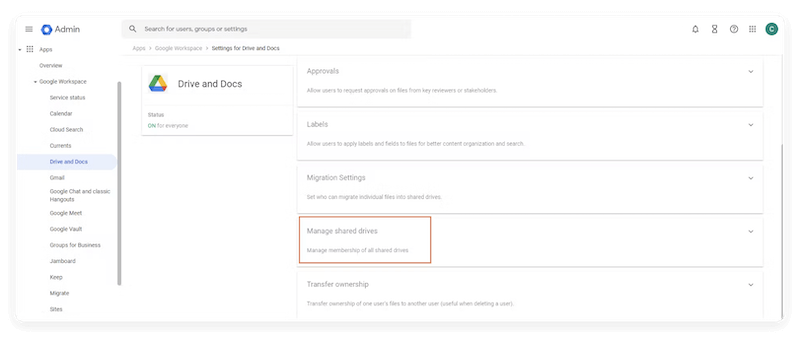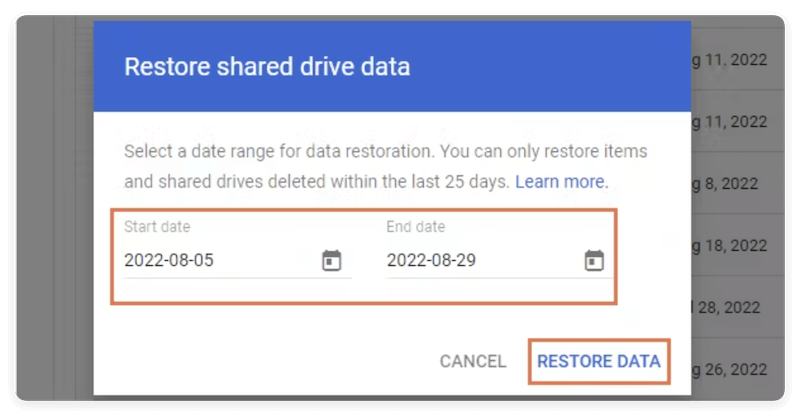Before we start: There are different methods to recover the files deleted from Google Drive. Also, if the files were ever on the local computers, you can use Donemax Data Recovery to recover the files from the local drive.
PAGE CONTENT:
Google Drive is one of the most widely used cloud storage solutions for individuals and businesses. With seamless file synchronization, generous free storage, and powerful sharing tools, it's a convenient way to store documents, photos, videos, and other data online. However, accidental deletions can happen—whether due to human error, device sync issues, or malware. If you've mistakenly deleted files or folders from Google Drive, don't panic. In many cases, you can recover them easily.

This comprehensive guide walks you through every available method to recover deleted files from Google Drive, whether you're a personal user or part of a Google Workspace organization.
How Google Drive Handles Deleted Files?
When you delete a file in Google Drive, it isn't gone forever—at least not immediately. Deleted items are moved to the Trash (also called Bin in some regions), where they stay temporarily. Here's what you should know:
- Files remain in the Trash folder for 30 days unless manually removed.
- During that period, users can easily restore files.
- After 30 days (or if manually deleted from Trash), files are considered permanently deleted.
- For Google Workspace users (business, enterprise, or educational accounts), administrators may have additional recovery options even after permanent deletion.
5 Methods to Recover Deleted Files from Google Drive
There are some solutions to recover the deleted files from the online Google Drive account or use data recovery software to recovery the data ever on the local drives.
Method 1: Recover Files from Google Drive Trash Folder
The first step in recovering deleted files is to check your Trash/Bin folder in Google Drive.
Step-by-Step Instructions:
- Open Google Drive
https://drive.google.com and sign in.
- Access the Trash
On the left-hand sidebar, click Trash or Bin.
- Locate Deleted Files
Browse or search for the file you want to recover. Files in the Trash can be sorted by date deleted.
- Restore the File
Right-click the file. Select Restore. The file will be returned to its original location.
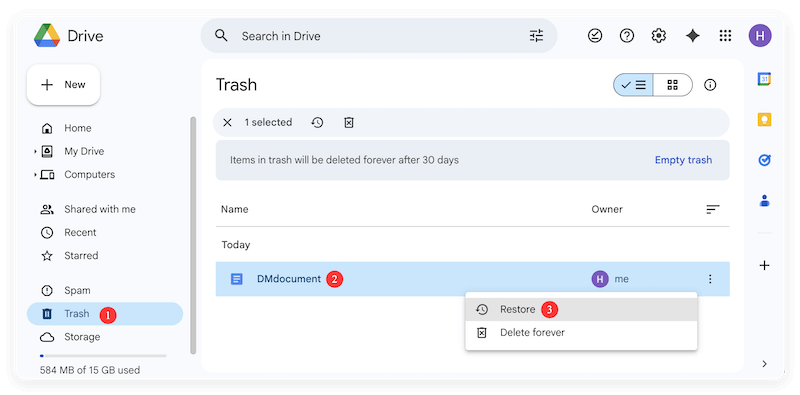
💡 Additional Notes:
- You can recover folders using the same method.
- If you deleted shared files, recovery depends on your ownership status. If someone else owns the file and you delete it from "Shared with me," it's only removed from your view, not theirs.
- File version history may also help you retrieve previous states of edited documents.
Method 2: Recover Permanently Deleted Files (Google Workspace Users)
If you're using a Google Workspace account, your domain administrator has advanced recovery tools that personal users do not.
Even after the file is removed from the Trash, a Google Workspace admin can recover files within 25 days using the Admin Console. So you can recover the data by administrator if possible.
Steps for Admins to Recover Files:
- Log in to the Admin Console
Visit admin.google.com and sign in with administrator credentials.
- Select the User
Go to Apps >Google Workspace > Drive and Docs > Manage shared drives. Find the user whose file you want to recover.
![recover deleted files from Google Drive]()
- Click Restore
Choose the date range (within the last 25 days) and click Restore Data. The files will reappear in the user's Drive within a few hours.
![recover deleted files from Google Drive]()
❌ Limitations:
- Admins can only recover items deleted in the past 25 days.
- This method does not work for Google Forms or files deleted before the retention period.
Method 3: Contact Google Support for Recovery Assistance
For users who do not have access to a Google Workspace admin—or if your file is no longer in Trash and beyond the 25-day admin recovery window—you can request help from Google Support.
When to Use This Option:
- You're a free user, and files are permanently gone.
- The deleted file is critical and cannot be reproduced.
- You're unsure how or when the file was deleted.
How to Contact Google Support:
- Go to Google Drive Help.
- Scroll down and click "Contact Us."
- Choose your issue (e.g., "Recover deleted files").
- Start a live chat or email conversation with support.
💡 Important Tips:
- Be ready to provide file names, approximate deletion dates, and folder structure.
- Google may not guarantee recovery, but in many cases, especially recent deletions, they may help.
Method 4: Recover Deleted Files via Google Drive for Desktop
If you've installed Google Drive for Desktop (formerly Backup and Sync), you may be able to recover deleted files from your local machine's Recycle Bin or Trash.
How It Works:
Google Drive for Desktop synchronizes cloud files with a folder on your computer. Deleting a synced file on your PC or Mac sends it to your system's Trash/Recycle Bin.
Steps to Recover Locally Deleted Files:
- Open your Recycle Bin (Windows) or Trash (Mac).
- Search for the deleted file.
- Right-click and select Restore or Put Back.
- The file should resync with Google Drive if sync is enabled.
Recover Deleted Files after Emptying the Trash
If the deleted files were also emptied from the local system Recycle bin or Trash, there is still a chance to recover the deleted files with a reliable data recovery software. Even after emptying the deleted files from Trash/Recycle bin, the data recovery software can still scan the drive deeply to look for the deleted files.
Here Donemax Data Recovery is highly suggested to recover the deleted files on local machine. The software is reliable with deep scan and advanced data recovery technologies. The software is easy and effective to recover the deleted files.
Donemax Data Recovery
- Recover deleted/lost data from local drive, USB drive, SD card, etc.
- Support data recovery effectively in different data loss cases.
- 100% safe and compatible with latest Windows and Mac systems.
Please do as follows to recover the files steps by step using Donemax Data Recovery:
1. Download and install the software on computer. Run the software and select the drive where the google files were located.
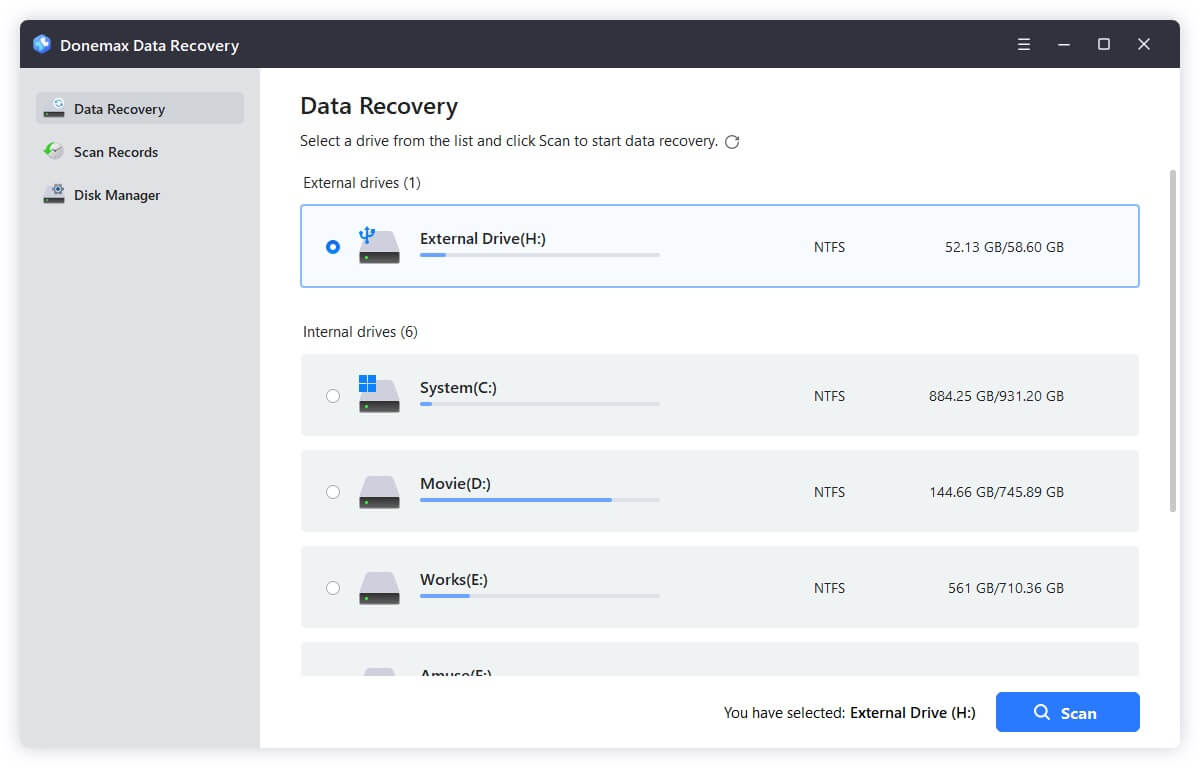
2. Start a scan to look for the deleted files on the drive. It can deeply scan the drive to find all possible missing files.
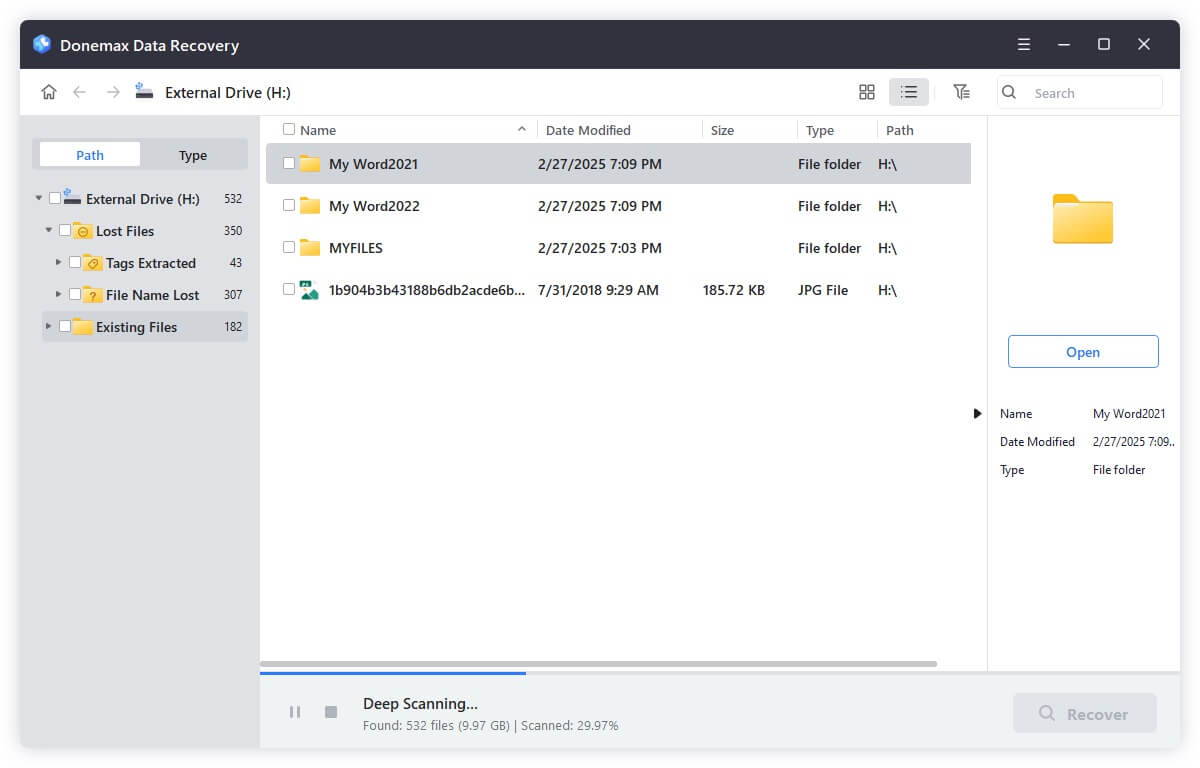
3. Check and find the wanted files after the scan is finished. Preview the files first and choose the recoverable data to recover to another drive.

Method 5: Use Google Takeout to Back Up Drive Files
Although Google Drive offers a reliable cloud storage system with built-in redundancy, users should still back up their files periodically—especially if the data is sensitive, irreplaceable, or work-critical. This is where Google Takeout comes in.
What is Google Takeout?
Google Takeout is a free tool developed by Google that allows users to export and download data from their Google account. It supports over 50 Google services, including Gmail, Calendar, Contacts, YouTube, and, of course, Google Drive.
This service can be used to:
- Back up your Drive data to an external hard drive or secondary cloud storage.
- Create a local archive before closing or switching Google accounts.
- Retain historical versions of important files.
Why Use Google Takeout for Drive?
Here are some key reasons why backing up your Drive data with Google Takeout is a smart move:
- Accidental Deletion Protection: Once files are permanently deleted from Trash, they're typically gone for good unless you're a Workspace user. Takeout helps you store a backup copy that can be restored anytime.
- Mitigates Sync Errors: Sometimes sync conflicts or Drive Desktop errors can cause data loss or overwrites. A Takeout archive serves as a recovery fallback.
- Migration Support: If you're switching accounts, such as moving from a school-issued Google account to a personal one, Takeout makes it easy to transfer your data.
- Compliance & Record Keeping: For businesses or legal purposes, creating periodic data exports ensures you have time-stamped copies of all relevant files.
Steps to Use Google Takeout:
- Visit https://takeout.google.com.
- Select the services to include (check Drive).
- Choose file format, frequency (one-time or recurring), and destination (e.g., email or cloud storage).
- Click Create Export.
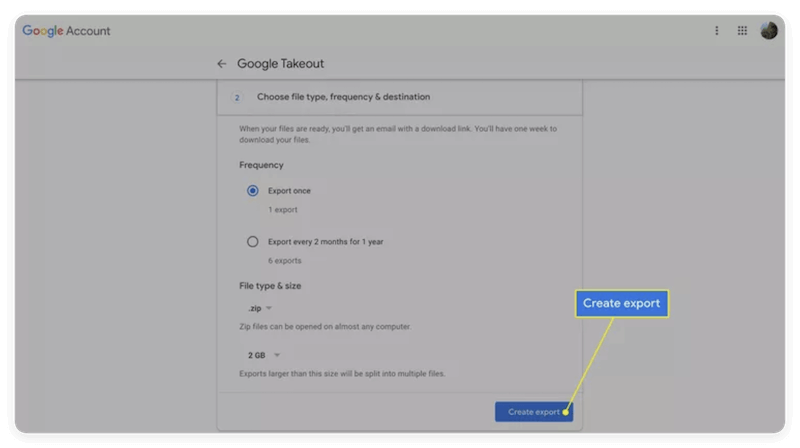
The export may take minutes or hours, depending on the amount of data.
💡 Tips and Considerations When Using Google Takeout
- Frequency: For critical or frequently updated files, set a monthly reminder to create a new backup.
- Storage Space: Ensure your local storage or external drive has enough space for the archive, especially if your Google Drive contains large media files.
- Encryption: For sensitive files, consider encrypting the downloaded archive using tools like VeraCrypt or 7-Zip with password protection.
- Shared Drives: Google Takeout does not support Shared Drives (from Google Workspace) unless you have access and explicitly include them.
- Folder Structure: The exported data maintains its folder hierarchy but may not always preserve Google Docs/Sheets/Slides in native formats. Instead, they're converted to:
- Google Docs → .docx
- Google Sheets → .xlsx
- Google Slides → .pptx
Bonus: Automate with Scheduled Exports
If you want to regularly back up your Drive, Google Takeout now offers a "Scheduled export" option:
- Under export frequency, choose:
- "Export once" (default), or
- "Export every 2 months for 1 year"
This is a great solution for long-term data safety with minimal manual effort.
Tips to Prevent Future Data Loss in Google Drive
Prevention is better than cure. Here are practical tips to avoid accidental deletions or permanent loss of important files:
1. Enable File Version History
Google Docs, Sheets, and Slides automatically save changes. You can view and restore previous versions:
- Open the document.
- Click File > Version history > See version history.
2. Use Offline Backup Tools
Consider backing up critical Google Drive data to a local drive or external cloud storage using:
- Google Drive for Desktop
- Third-party backup apps like Insync, MultCloud, or Backupify
3. Avoid Overwriting with Sync Conflicts
Sometimes syncing issues can cause file conflicts or overwrites. To reduce this risk:
- Don't use multiple sync apps simultaneously.
- Label important files with "Do Not Modify" or use shared viewing access.
4. Educate Team Members
If you're in a team environment, ensure everyone understands how deletion and sharing permissions work.
5. Set Up Alerts for Drive Usage
Google Workspace admins can configure alerting rules for file deletion, sharing, or permission changes.
Conclusion
Recovering deleted files from Google Drive is not only possible—it's often simple if you act quickly. Whether you're an individual user or part of an organization, Google offers multiple recovery paths:
- Check your Trash folder first.
- Ask your administrator if you're on Google Workspace.
- Contact Google support if all else fails.
- Use Google Drive for Desktop to explore local copies.
- Back up your Drive with Google Takeout or third-party tools.
For long-term peace of mind, it's crucial to implement proactive file management and backup strategies. By doing so, you'll protect your valuable data from accidental loss and ensure it's always within reach.


Donemax Data Recovery
Powerful, safe & easy-to-use data recovery software. Easily and completely recover deleted, formatted, or other lost data. The tool supports PC, Mac, HDD, SSD, USB drive, camera, SD card, RAID and other storage devices.
Related Articles
- May 16, 2025What is a DNG File? How to Recover Lost DNG RAW Images?
- May 20, 2025Best 4 Methods to Recover Deleted JPEG Images
- Jun 11, 2025How to Recover Deleted C4D Files in Cinema 4D?
- Jul 02, 2025Best 4 Methods to Recover Deleted SWF File
- Jun 06, 2025How to Recover Deleted ASF Files? [4 Methods]
- Jun 06, 2025How to Recover Deleted MP3 Audio or Music Files?

Charles
Charles, who lives in Sydney, Australia, is an editor & writer of Donemax Team. He is good at writing articles related with Apple Mac computers, Windows operating systems, data recovery, data erasure, disk clone and data backup, etc. He loves reading and playing tennis in his spare time and is interested in testing new digital devices such as mobile phones, Macs, HDDs, SSDs, digital cameras, etc.

Gerhard Chou
In order to effectively solve the problems for our customers, every article and troubleshooting solution published on our website has been strictly tested and practiced. Our editors love researching and using computers and testing software, and are willing to help computer users with their problems

